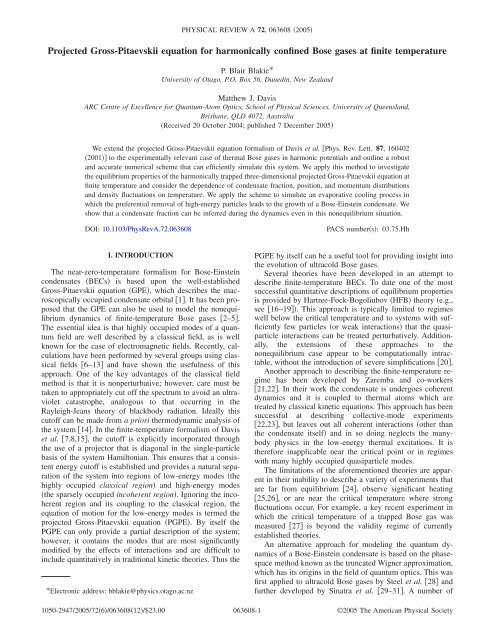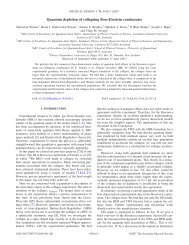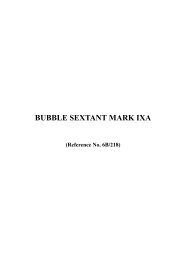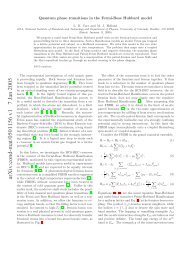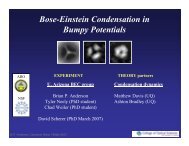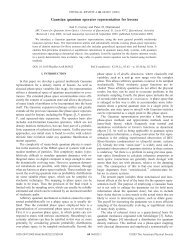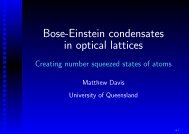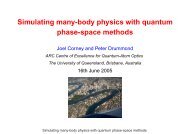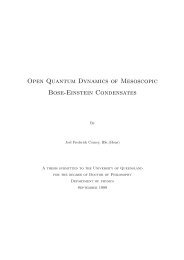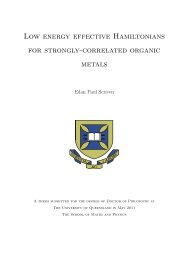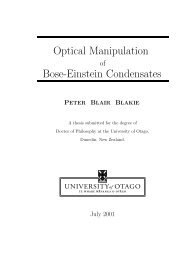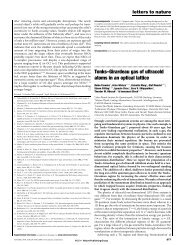Projected Gross-Pitaevskii equation for harmonically ... - Physics
Projected Gross-Pitaevskii equation for harmonically ... - Physics
Projected Gross-Pitaevskii equation for harmonically ... - Physics
You also want an ePaper? Increase the reach of your titles
YUMPU automatically turns print PDFs into web optimized ePapers that Google loves.
PHYSICAL REVIEW A 72, 063608 2005<strong>Projected</strong> <strong>Gross</strong>-<strong>Pitaevskii</strong> <strong>equation</strong> <strong>for</strong> <strong>harmonically</strong> confined Bose gases at finite temperatureP. Blair Blakie*University of Otago, P.O. Box 56, Dunedin, New ZealandMatthew J. DavisARC Centre of Excellence <strong>for</strong> Quantum-Atom Optics, School of Physical Sciences, University of Queensland,Brisbane, QLD 4072, AustraliaReceived 20 October 2004; published 7 December 2005We extend the projected <strong>Gross</strong>-<strong>Pitaevskii</strong> <strong>equation</strong> <strong>for</strong>malism of Davis et al. Phys. Rev. Lett. 87, 1604022001 to the experimentally relevant case of thermal Bose gases in harmonic potentials and outline a robustand accurate numerical scheme that can efficiently simulate this system. We apply this method to investigatethe equilibrium properties of the <strong>harmonically</strong> trapped three-dimensional projected <strong>Gross</strong>-<strong>Pitaevskii</strong> <strong>equation</strong> atfinite temperature and consider the dependence of condensate fraction, position, and momentum distributionsand density fluctuations on temperature. We apply the scheme to simulate an evaporative cooling process inwhich the preferential removal of high-energy particles leads to the growth of a Bose-Einstein condensate. Weshow that a condensate fraction can be inferred during the dynamics even in this nonequilibrium situation.DOI: 10.1103/PhysRevA.72.063608PACS numbers: 03.75.HhI. INTRODUCTIONThe near-zero-temperature <strong>for</strong>malism <strong>for</strong> Bose-Einsteincondensates BECs is based upon the well-established<strong>Gross</strong>-<strong>Pitaevskii</strong> <strong>equation</strong> GPE, which describes the macroscopicallyoccupied condensate orbital 1. It has been proposedthat the GPE can also be used to model the nonequilibriumdynamics of finite-temperature Bose gases 2–5.The essential idea is that highly occupied modes of a quantumfield are well described by a classical field, as is wellknown <strong>for</strong> the case of electromagnetic fields. Recently, calculationshave been per<strong>for</strong>med by several groups using classicalfields 6–13 and have shown the usefulness of thisapproach. One of the key advantages of the classical fieldmethod is that it is nonperturbative; however, care must betaken to appropriately cut off the spectrum to avoid an ultravioletcatastrophe, analogous to that occurring in theRayleigh-Jeans theory of blackbody radiation. Ideally thiscutoff can be made from a priori thermodynamic analysis ofthe system 14. In the finite-temperature <strong>for</strong>malism of Daviset al. 7,8,15, the cutoff is explicitly incorporated throughthe use of a projector that is diagonal in the single-particlebasis of the system Hamiltonian. This ensures that a consistentenergy cutoff is established and provides a natural separationof the system into regions of low-energy modes thehighly occupied classical region and high-energy modesthe sparsely occupied incoherent region. Ignoring the incoherentregion and its coupling to the classical region, the<strong>equation</strong> of motion <strong>for</strong> the low-energy modes is termed theprojected <strong>Gross</strong>-<strong>Pitaevskii</strong> <strong>equation</strong> PGPE. By itself thePGPE can only provide a partial description of the system;however, it contains the modes that are most significantlymodified by the effects of interactions and are difficult toinclude quantitatively in traditional kinetic theories. Thus the*Electronic address: bblakie@physics.otago.ac.nzPGPE by itself can be a useful tool <strong>for</strong> providing insight intothe evolution of ultracold Bose gases.Several theories have been developed in an attempt todescribe finite-temperature BECs. To date one of the mostsuccessful quantitative descriptions of equilibrium propertiesis provided by Hartree-Fock-Bogoliubov HFB theory e.g.,see 16–19. This approach is typically limited to regimeswell below the critical temperature and to systems with sufficientlyfew particles or weak interactions that the quasiparticleinteractions can be treated perturbatively. Additionally,the extensions of these approaches to thenonequilibrium case appear to be computationally intractable,without the introduction of severe simplifications 20.Another approach to describing the finite-temperature regimehas been developed by Zaremba and co-workers21,22. In their work the condensate is undergoes coherentdynamics and it is coupled to thermal atoms which aretreated by classical kinetic <strong>equation</strong>s. This approach has beensuccessful at describing collective-mode experiments22,23, but leaves out all coherent interactions other thanthe condensate itself and in so doing neglects the manybodyphysics in the low-energy thermal excitations. It isthere<strong>for</strong>e inapplicable near the critical point or in regimeswith many highly occupied quasiparticle modes.The limitations of the a<strong>for</strong>ementioned theories are apparentin their inability to describe a variety of experiments thatare far from equilibrium 24, observe significant heating25,26, or are near the critical temperature where strongfluctuations occur. For example, a key recent experiment inwhich the critical temperature of a trapped Bose gas wasmeasured 27 is beyond the validity regime of currentlyestablished theories.An alternative approach <strong>for</strong> modeling the quantum dynamicsof a Bose-Einstein condensate is based on the phasespacemethod known as the truncated Wigner approximation,which has its origins in the field of quantum optics. This wasfirst applied to ultracold Bose gases by Steel et al. 28 andfurther developed by Sinatra et al. 29–31. A number of1050-2947/2005/726/06360812/$23.00063608-1©2005 The American Physical Society
P. B. BLAKIE and M. J. DAVIS PHYSICAL REVIEW A 72, 063608 2005recent calculations using this method can be found in Refs.32–36. The stochastic GPE <strong>for</strong>malism developed by Gardineret al. 37,38 is derived from a truncated Wigner approximationand proposes a practical scheme <strong>for</strong> couplingthe classical and incoherent regions in a manner suitable <strong>for</strong>nonequilibrium calculations. To account <strong>for</strong> the interactionwith the incoherent region, this <strong>for</strong>malism introduces noiseterms into the PGPE that transfer energy and particles intoand out of the coherent region. A similar scheme was earlierderived by Stoof 39 using field-theoretic techniques.The main purpose of this paper is to develop the PGPEapproach <strong>for</strong> the experimentally relevant case of threedimensionalharmonic traps. To do this we have adapted arecent numerical scheme by Dion and Cancès 40 by introducingan explicit energy cutoff in the single-particle harmonicoscillator basis. We use the scheme to examine theproperties of the trapped PGPE system as a function of thetemperature, such as condensate fraction and density fluctuations.While some of these properties were studied in Ref.11, we believe that our numerical method is superior andour results are free from the significant uncertainties found inthat work. Finally, as a nonequilibrium demonstration of themethod we use the PGPE to simulate the <strong>for</strong>mation of aBose-Einstein condensate in an evaporatively cooled thermalcloud.There is one important point we should make be<strong>for</strong>e continuingwith the main body of this work. We would like toemphasize that the results presented in this paper are notintended <strong>for</strong> direct comparison with experimental systems, asthe PGPE description employed here neglects the highenergymodes of the gas. While individually these modes aresparsely occupied, collectively they may contain a large fractionof the total number of atoms of the corresponding physicallyrelevant situation due to the rapid increase in the densityof states with energy. Some earlier calculationsemploying the classical field approach have neglected theeffects of the above cutoff atoms—e.g., 11,13; however, webelieve that this is not valid as in some circumstances morethat 90% of atoms can be found in the above cutoff modes.The results presented here are intended to demonstrate thephysics that is contained in the PGPE description and are aqualitative indication of what can be expected when thehigh-energy modes are included. We consider that the workpresented is an important step towards the goal of per<strong>for</strong>mingexperimentally realistic calculations using classical fieldsat finite temperature with small uncertainties.II. FORMALISMThe theoretical <strong>for</strong>malism we numerically implement inthis paper has been developed in Refs. 7,8,15,38, and herewe briefly summarize the main points of this <strong>for</strong>malism,adapted <strong>for</strong> application to inhomogeneous systems.A dilute Bose gas is well described by the secondquantizedHamiltonianwhereĤ = Ĥ sp + Ĥ I ,1Ĥ sp = d 3 x˜ˆ † x˜− 22m 2 + V trap x˜ˆ x˜,Ĥ I = 1 2 U 0 d 3 x˜ˆ † x˜ˆ † x˜ˆ x˜ˆ x˜are the single-particle and interaction Hamiltonians, respectively,and ˆ x˜ is the quantum Bose field operator that annihilatesa particle at position x˜. The inclusion of an externaltrapping potential, assumed to be harmonic in <strong>for</strong>m, i.e.,23V trap x˜ = 1 2 m 2 z 2 x x˜2 + 2 y ỹ 2 + z˜2, 4is the major new feature of this paper as compared to theearlier numerical investigations made by one of us in Refs.7,8. InEq.3 particle interactions have been approximatedby a contact interaction of strength U 0 =4 2 a/m, where mis the atomic mass and a is the s-wave scattering length. Theharmonic trap geometry is defined by the angular oscillationfrequencies along each axis: i.e., x , y , and z . For conveniencewe express the x and y frequencies relative to z ,byintroducing the relative frequency parameters x x / z and y y / z .The exact <strong>equation</strong> of motion <strong>for</strong> the field operator isgiven by the Heisenberg <strong>equation</strong> of motionˆ 2i =−t˜ 2m 2 + V trap x˜ˆ x˜ + U 0 ˆ † x˜ˆ x˜ˆ x˜.5For situations of experimental relevance the Hilbert space isenormously large, and directly solving Eq. 5 is not possiblewithout further approximation. The essence of our approachis to split the field operator into two parts representing thecoherent and incoherent regions. We define the projectionoperatorsPFx˜ = n x˜ d 3 x˜ * n x˜Fx˜,nCQFx˜ = n x˜ d 3 x˜ * n x˜Fx˜, 7nCwhere nC defines the modes that make up the coherentregion C and n x˜ is the nth eigenfunction of the basis thatdiagonalizes single-particle Hamiltonian Ĥ sp . We defineˆ x˜ = Pˆ x˜,ˆ x˜ = Qˆ x˜,which we refer to as the coherent ˆ and incoherent ˆ field operators, respectively. This division is based on theaverage occupation of the states. The coherent field ˆ ischosen to describe the low-lying, highly occupied states ofthe system, i.e., modes containing order of 5 or more particles.The incoherent field ˆ x˜ contains the complementary68063608-2
PROJECTED GROSS-PITAEVSKII EQUATION FOR…states which are sparsely occupied. Our particular interest isin situations near equilibrium, where this separation can beconveniently introduced via thermodynamic arguments bymaking an appropriate energy cutoff Ẽ cut in the singleparticlespectrum.To derive the PGPE, we apply the projection operator 6to the <strong>equation</strong> of motion <strong>for</strong> the field operator 5. The fundamentalapproximation we make, often referred to as theclassical field approximation, is to neglect the quantummechanicalnature of the coherent field operator—i.e., setˆ x˜→x˜ a c-number function—due to the high occupationnumbers of these modes. By making this approximation,the <strong>equation</strong> of motion 5 is trans<strong>for</strong>med into a <strong>for</strong>minvolving couplings between the coherent and incoherentfields of some complexity e.g., see 15. As a further approximationwe neglect the interaction between the coherentand incoherent regions and simply consider the <strong>equation</strong> ofmotion <strong>for</strong> x˜ in isolation:i x˜t=− 22m 2 + V trap x˜x˜ + PU 0 x˜ 2 x˜,9which is the projected <strong>Gross</strong>-<strong>Pitaevskii</strong> <strong>equation</strong>. This <strong>equation</strong>is of a similar <strong>for</strong>m as the usual <strong>Gross</strong>-<strong>Pitaevskii</strong> <strong>equation</strong>;however, the classical field x˜ has a distinct interpretation:It represents the quantum field <strong>for</strong> many low-lyingmodes, rather than just the condensate mode. Several substantialapproximations have been made to reduce the fullHeisenberg <strong>equation</strong> of motion <strong>for</strong> the field 5 to the PGPE9; however, previous studies have demonstrated that thisfinal <strong>for</strong>m contains a rich set of physics e.g., see7,8,10,11.III. NUMERICAL APPROACHThe modes of the system are of central importance in theassumptions used to derive the PGPE, and care must betaken in numerical implementations to ensure the modes arefaithfully represented. It is in our opinion that any usefulsimulation technique must satisfy the following requirements.i The space spanned by the modes of the simulationshould match that of the coherent region of the physical systembeing simulated as closely as possible. That is, themodes should be the single-particle modes of the system upto the prescribed energy cutoff Ẽ cut .ii The assumption of high occupancy in all modes necessitatesthat the numerical scheme must propagate allmodes accurately.Most commonly used methods <strong>for</strong> propagatingSchrödinger-type <strong>equation</strong>s do not satisfy these requirements;in particular, many methods do not propagate allmodes of the numerical basis faithfully. This leads to negligibleerrors if the highest modes are unoccupied, as is thecase <strong>for</strong> the T=0 GPE. However, it is clear that methodsbased on such assumptions will not be appropriate <strong>for</strong> simulatingthe PGPE.Be<strong>for</strong>e introducing the numerical scheme used in this paper,we review how the method used by Davis et al. 7–9 tosimulate homogeneous Bose gases addresses the a<strong>for</strong>ementionedconditions. For the homogeneous system the modesare plane-waves and are suitable to grid Fourier methods ofpropagation also used in 13,41. To define the coherentregion Davis et al. instigated an energy cutoff by using anexplicit projection operator in momentum space, ensuringcondition i was satisfied. To satisfy condition ii sufficientlymany states outside the cutoff should be retained toensure that the nonlinear terms in the evolution <strong>equation</strong>were exactly evaluated without aliasing <strong>for</strong> all modes of thecoherent region. This was not realized at the time, and aliasingis present in the calculations presented in 7–9. However,the presence of aliasing mainly modifies the action ofthe nonlinear term and does not affect the equilibrium stateor the conclusions reached in these papers.We comment that simply using an unmodified gridmethod as in 13,41 does introduce a cutoff into the systemin momentum space, but does not satisfy the two criterialisted above. First, the energy cutoff is anisotropic, varyingin magnitude by a factor of 3 with direction in momentumspace in three dimensions. Second, the largest momentumstates will be aliased in the calculation of nonlinear termsand their dynamics will be misrepresented. The situation iseven worse when using an unmodified grid method to simulateclassical field dynamics <strong>for</strong> a trapped Bose gas as in6,11,12. It is this issue that we address here.A. Brief review of the numerical methodThe method we have used to simulate the projected<strong>Gross</strong>-<strong>Pitaevskii</strong> <strong>equation</strong> 9 with an explicit cutoff in energyderives from a recent numerical scheme by Dion andCancès 40. We briefly review our adaption of this method.To begin, we rescale the projected <strong>Gross</strong>-<strong>Pitaevskii</strong> <strong>equation</strong>9 by introducing units of distance x 0 = /2mz , timet 0 = z −1 , and hence energy z , with z the trap frequencyalong the z direction. With these choices, we havei t=− 2 + 1 4 2 xx 2 + 2 y y 2 + z 2 + C nl 2 ,10where we have defined the nonlinear coefficient as C nl=N C U 0 / z x 0 3 and <strong>for</strong> clarity have used untilded variables toindicate quantities expressed in computational units. We takethe wave function to be normalized to unity, so that the totalnumber of atoms within the coherent region, N C , appears inthe definition of the nonlinearity constant. To simplify ourdiscussion of the numerical method, we will take the harmonictrapping potential to be isotropic—i.e., x = y =1.This allows us to avoid using cumbersome notation to account<strong>for</strong> different spectral bases in each direction.The classical field x,t is expanded asx,t =PHYSICAL REVIEW A 72, 063608 2005l,m,nCc lmn t l x m y n z,11where n x are the eigenstates of the one-dimensional1D harmonic oscillator Hamiltonian satisfying063608-3
P. B. BLAKIE and M. J. DAVIS PHYSICAL REVIEW A 72, 063608 2005− d2dx 2 + 1 4 x2 n x = n n x,12with eigenvalue n = n+12 . The energy cutoff is implementedby restricting the summation indices to the setC = l,m,n: l + m + n E cut ,13with the value of E cut chosen to be appropriate <strong>for</strong> the physicalsystem under consideration. For later convenience wedefine n cut to be the largest index occurring in C—i.e., thequantum number of the highest-energy oscillator state in thecoherent region i.e., n cut Ẽ cut / z .In the basis representation, the PGPE 10 takes the <strong>for</strong>mwherec lmn=−i l + m + n c lmn + C nl F lmn ,t14F lmn d 3 x l * x m * y n * zx,t 2 x,t 15is the matrix element of the nonlinear term. An importantobservation made in Ref. 40 is that these matrix elements15 can be computed exactly with an appropriately chosenGauss-Hermite quadrature. To show this we note that becausethe harmonic oscillator states are of the <strong>for</strong>m n xH n xexp−x 2 /4, where H n x is a Hermite polynomial ofdegree n, the wave function can be written asx = Qx,y,ze −x2 +y 2 +z 2 /4 ,16where Qx,y,z is a polynomial that, as a result of the cutoff,is of maximum degree n cut in the independent variables.It follows that because the interaction term 15 is fourthorder in the wave function, it can be written in the <strong>for</strong>mF lmn = d 3 xe −x2 +y 2 +z 2 Px,y,z,17where Px,y,z is a polynomial of maximum degree 4n cut inthe independent variables. Identifying the exponential termas the usual weight function <strong>for</strong> Gauss-Hermite quadrature,the integral can be exactly evaluated using a threedimensionalspatial quadrature grid of 8n cut 3 points. Thuswe have verified that the matrix elements F lmn can beexactly calculated. We refer the reader to Ref. 40 <strong>for</strong> moredetails of how to efficiently implement the spatial trans<strong>for</strong>mationand numerical quadrature.IV. SIMULATION PROCEDUREA. Microcanonical ergodic evolutionThe evolution of the classical field preserves several constantsof motion. These can be considered as macroscopicparameters that constrain the microstates available to the system.For the PGPE, the most important such constant ofmotion is the total energy, given by the energy functionalE = d 3 x˜ * x˜− 22m 2 + V trap x˜x˜+ 1 2 U 0x˜ 4. 18Another important constant of motion is the field normalization,given byN = d 3 x˜x˜ 2 .As discussed in Sec. III A, we take the classical field to benormalized to unity <strong>for</strong> the initial condition: a scaling choicethat causes the coefficient of the nonlinear term in the PGPEto be proportional to the initial number of particles in thecoherent region. The PGPE may have other constants of motion,such as angular momentum components in traps withthe appropriate symmetry; however, here we will only considersituations where these are approximately zero and canbe neglected.The lowest-energy solution to the energy functional isgiven by the time-independent <strong>Gross</strong>-<strong>Pitaevskii</strong> <strong>equation</strong>e.g., see Ref. 42. We denote the energy of this solutionE g . This solution corresponds to T=0; however, this situationlies outside the validity regime of the PGPE since only asingle mode—i.e., the condensate mode—is highly occupied.For application of the PGPE our interest is in regimes withEE g such that the system is at finite temperature withmany highly occupied modes.For the simulations we present here we make use of theergodic hypothesis, which we discuss further below. However,an immediate consequence of ergodicity <strong>for</strong> the studyof equilibrium properties is that the precise details of theinitial conditions in a simulation are irrelevant. In practicewe choose initial conditions to provide the desired values <strong>for</strong>the constants of motion. The amplitudes <strong>for</strong> each singleparticlemode have a random phase and occupation, but areconstrained to fix the overall normalization to unity and theenergy to the desired value. In general such an initial choicewill not be a typical equilibrium state, but under evolutionthe system rapidly thermalizes. This thermalization processhas been investigated <strong>for</strong> the homogeneous case in 8. InFig. 1 we show typical density profiles of thermalized classicalfields <strong>for</strong> the <strong>harmonically</strong> trapped system. The cases inFigs. 1a and 1b differ in the energy of the fields. It is clearfrom these figures that the classical field has a somewhatchaotic appearance, and this undergoes constant evolution asthe constituent modes mix through the nonlinear interaction.B. Time-averaging correlation functionsThe energy functional 18 is nonlinear, and it is not feasibleto determine the entire phase space of classical fieldconfigurations consistent with a particular choice of energy.This prohibits the calculation of quantities using an ensembleaveraging approach. However, we can determine correlationfunctions <strong>for</strong> the system by using the ergodic hypothesis—i.e., replacing ensemble averages by time averages followingthe prescription063608-4
PROJECTED GROSS-PITAEVSKII EQUATION FOR…PHYSICAL REVIEW A 72, 063608 2005field taken over an evolution time of approximately 191 oscillatorperiods i.e., t Ns −t 1 =1200/ z .FIG. 1. Thermalized classical fields <strong>for</strong> two values of energy.Density slices taken in the y=0 plane <strong>for</strong> a system in an anisotropictrap with x = 8 and y =1. a Low-energy case with an averageenergy per particle of E=10 z . b Higher-energy case with anaverage energy per particle of E=24 z . For both simulations C nl=2000 and the ground-state energy is E g =8.54 z . The singleparticlecutoff energy is E cut =31 z , below which 1739 singleparticlestates remain in the coherent region.F C x ensemble = lim→ 1 dtF C x,t ,0where F C x is some functional correlation function ofthe field.The general spatial correlation functions we are interestedin are usually expressed as an ensemble average over a productof quantum field operators such asF Q = ˆ † x 1 ¯ ˆ † x j ˆ x j+1 ¯ ˆ x n .Note that we have only considered correlation functions thatinvolve the field operator <strong>for</strong> the coherent region. Also wehave restricted our attention to same-time correlations; however,in principle multitime correlation functions could alsobe computed. To evaluate these correlation functions withinthe framework of the classical field theory we make the substitutionˆ x→x, as discussed in Sec. II, and replaceensemble averaging with time averaging. The resulting expressionthat we evaluate numerically isF C x time ave = 1 N sN s F C x,t j ,j=1where t j is a set of N s equally spaced time instances atwhich the classical field has been calculated. For this choiceto well approximate the ensemble average we require N s1, and the time span over which averaging is done to belong compared to the slowest time scale in the problem—e.g., the longest harmonic oscillator period. For the equilibriumresults we present in this paper these conditions arewell satisfied: we use 1400 discrete samples of the classicalC. TemperatureFor comparison with experiments and other theories it iscrucial to be able to identify the temperature of the classicalfield simulations rather characterize a particular result by itsenergy. Previous attempts to determine temperature havebeen based on fitting the occupation of high-energy modes toperturbative calculations <strong>for</strong> the spectrum based on Hartree-Fock-Bogoliubov HFB theory 7,8. For <strong>harmonically</strong>trapped gases, calculation of the HFB modes is much moredifficult and limits temperature calculations to perturbativeregimes. Gòral et al. 11 have estimated the temperature in<strong>harmonically</strong> trapped classical field simulations, in a manneranalogous to that done in experiments, by fitting the highmomentumcomponents of the system to a noninteractingdistribution. The results of that analysis suffered from excessivelylarge errors and indicate that this approach would notbe useful <strong>for</strong> any systematic investigation of thermodynamicproperties. In addition, the high-energy modes of these calculationsare unlikely to have been represented accurately43.In recent work 9 one of us has generalized Rugh’s dynamicaldefinition of temperature 44 to the PGPE. Thisscheme has the advantage that it is nonperturbative and isquite accurate. This scheme can be extended to the <strong>harmonically</strong>trapped case and is used to calculate the temperature ofthe simulations presented in this paper. Because the implementationof this scheme in the <strong>harmonically</strong> trapped case isa trivial extension to the homogeneous implementation, werefer the reader to Ref. 9 <strong>for</strong> details.V. RESULTSFor the results presented in this paper we have simulateda 3D PGPE system with x = 8, y =1, and an energy cutoffof E cut =31 z . These choices lead to a coherent region containing1739 harmonic oscillator modes. We would like toemphasize that these choices are somewhat arbitrary <strong>for</strong> thispaper and are designed only to provide a demonstration ofthe PGPE methods described below. In the future when itcomes to describing realistic Bose-condensed systems it willbe necessary to choose the cutoff carefully, depending on thetemperature, the number of atoms, and the geometry of thesystem to be simulated to ensure that the requirement of highoccupation numbers is satisfied. It will also be necessary torepresent in some manner the atoms in the incoherent regionthat are being neglected in this paper see 45.Thus the numerical results in this section should beviewed as a demonstration of the physics that can be describedwith the classical field method starting from verysimple theoretical premises, rather than accurately representinga trapped Bose gas system. We will begin to make thisextension to realistic systems in our next piece of work onthis topic 45. The system that is being described here is anidealized “PGPE system,” which contains a fixed number of063608-5
P. B. BLAKIE and M. J. DAVIS PHYSICAL REVIEW A 72, 063608 2005particles distributed over the finite number of modes in thecoherent region.An important question that might be asked by the readeris, what is the effect of changing the value of E cut ? A largervalue <strong>for</strong> the energy cutoff will lead to more modes beingincluded in the coherent region. Physically this would correspondto a system that is at a higher temperature, such thatmodes at the new value of E cut satisfy the high occupancycondition. The characteristic time and energy scales willchange in some manner, but overall the results will be qualitativelysimilar.A. Condensation1. Condensate fractionIdentification of the condensate fraction and mode function<strong>for</strong> an inhomogeneous system with interactions is nontrivial.This issue was addressed by Penrose and Onsager in1956 46, who extended the concept of Bose-Einstein condensationfrom an ideal gas to the case of superfluid helium.Their primary criterion <strong>for</strong> condensation is that a single eigenvaluen 0 of the one-body density matrix x,x becomesan extensive parameter of the system. With regard to obtaininga quantitative description of the condensate, they alsoshowed that n 0 and its corresponding eigenvector are thecondensate occupation and mode, respectively.The one-body density matrix can be written as an ensembleaverage of the quantum field operators as follows:x,xˆ † xˆ x ensemble . 19As we neglect the incoherent region in this paper, we restrictour consideration to the one-body density matrix <strong>for</strong> the coherentregion—i.e., C x,xˆ † xˆ x ensemble —andusing the procedure outlined in Sec. IV B, we calculate thismatrix as C x,x 1 N sN s * x,t j x,t j . 20j=1It is more convenient numerically to represent the densitymatrix in the spectral representation ij = 1 N sN s c * i t n c j t n ,21n=1where c j t n are the spectral amplitudes of the classical fieldat time t n and the index j labels all three quantum numbersneeded to specify the oscillator mode that c j refers to. Theefficiency of the spectral representation af<strong>for</strong>ds us the abilityto work with the entire one-body density matrix. The onebodydensity matrix was also time averaged in the grid-basedmethod reported in Ref. 11; however, their analysis waslimited to the s-wave component.In Fig. 2 we show the condensate fraction f c n 0 /N C and temperature calculated from simulations of the PGPEusing a range of energies as determined by the energy functional18. For systems with a fixed total number of particles,the portion of atoms in the coherent region and theFIG. 2. Equilibrium properties calculated using the PGPE. aThe condensate fraction f c and b temperature, calculated as afunction of energy <strong>for</strong> C nl =1000. Other simulation parameters arethe same as in Fig. 1. The averaging was per<strong>for</strong>med using N s=1400 samples over a evolution period of T=1200/ z . The unit oftemperature is T 0 =N C z /k B 9, where k B is the Boltzmannconstant.cutoff energy used to define the coherent region will changewith temperature. These issues will be important considerationsin making experimental comparisons. However, thisissue is worthy of much further discussion than is appropriatehere, and we refer the reader to 45 <strong>for</strong> the investigationof the different components of the overall shift in T c , as wellas our application of the PGPE as a quantitative model of theexperiments of Gerbier et al. 27, by including a representationof the above cutoff atoms. Per<strong>for</strong>ming calculations <strong>for</strong>higher C nl we note that T c decreases with increasing C nl ,asisexpected. We refer the reader to Ref. 45 <strong>for</strong> an in-depthdiscussion of this behavior.a. Suitable averaging to determine the condensate fraction.Using linear algebra arguments it can be shown that thecondensate fraction <strong>for</strong> the PGPE system determined accordingto the prescription we have outlined above will have alower bound off c max1/N s ,1/G C ,22where N s is the number of samples used to construct thedensity matrix in Eq. 21 and G C is the number of singleparticlestates in the coherent region. Typically we take N sG C so that 1/N s <strong>for</strong>ms a lower bound <strong>for</strong> the condensatefraction. Equality in the bound holds if the individual classicalfields included in the time average are mutuallyorthogonal—i.e., if j c j * t m c j t n = mn ∀m,n:1m,nN s . The result 22 implies, <strong>for</strong> instance, that to determinea condensate fraction below 1% will require us to take N s100 samples.2. Condensation: Influence on density distributions inmomentum and position spaceIt is interesting to consider how the presence of a condensateaffects the position and momentum density profiles ofthe system. Indeed, it was the appearance of an anisotropic063608-6
PROJECTED GROSS-PITAEVSKII EQUATION FOR…PHYSICAL REVIEW A 72, 063608 2005FIG. 3. Time-averaged column densities in momentum a–c and position d–e space of classical field simulations with variousenergies. Cases: a and d E=24 z , b and e E=18 z , and c and f E=10 z . Other simulation parameters are the same as in Fig.1. The averaging was per<strong>for</strong>med using N s =1400 samples over a evolution period of T=1200/ z .peak in the momentum distribution that was used as one ofthe signatures of condensation in the first experiments 47.In Figs. 3a–3c we compute the momentum columndensity <strong>for</strong> cases above and below the transitiontemperature. In detail, the quantity we calculate is themomentum-space column density given by dk y k,t 2i.e., integrated along the k y direction, where k,t=2 −3/2 d 3 x exp−ik·xx,t is the momentum-spacewave function and k=k x ,k y ,k z . Time-averaging this, i.e.,calculating K k x ,k z = 1 N sN s dk y k,t j 2 ,j=1yields the average column density shown in Figs. 3a–3c.The peak momentum density of the three cases consideredvaries over a wide range, and <strong>for</strong> presentation clarity wehave used a logarithmic density scale in Figs. 3a–3c. Theappearance of a narrow peak in the momentum distribution<strong>for</strong> the condensed state is clearly observed in Figs. 3b and3c; however, the logarithmic density scale somewhat suppressesthe prominence of this feature: the peak momentumcolumn density in Fig. 3c is 26 times larger than the peakdensity in Fig. 3a. We also note that the momentum distributionchanges from being isotropic in Fig. 3a where thereis no condensate as calculated according to the criterion inSec. V A 1 to exhibiting distinctive anisotropy <strong>for</strong> the condensatemomentum peak in Figs. 3b and 3c. This anisotropyis directly related to the ratio of the trap frequencies.The usual experimental method <strong>for</strong> imaging the momentumdistribution is to take an absorption image of the system afterallowing it freely expand in the absence of the trap. Interactioneffects during expansion significantly suppresses thecontrast in momentum widths of condensed and uncondensedsystems. However, the contrast has been revealed byexperiments using Bragg spectroscopy techniques 48 thatare able to probe the momentum distribution in situ.Similarly we can construct the column density distributionin position space as R x,z = 1 N sN s dyx,t j 2 .j=1This is equivalently obtained by integrating out the y directionof the diagonal one-body density matrix C x,x, Eq.20. These distributions are shown beneath the associatedmomentum distribution in Figs. 3d–3f. These results emphasizethat while the momentum distribution undergoessubstantial changes at the transition as discussed above, theposition distribution changes in a much more subtle manner.063608-7
P. B. BLAKIE and M. J. DAVIS PHYSICAL REVIEW A 72, 063608 2005The calculations presented in 11 looked only at positionrepresentations of the system.B. Density fluctuationsDetermining the condensate fraction using the Penrose-Onsager criterion is a probe of first-order coherence in thesystem. Indeed, the existence of a condensate is equivalent tooff-diagonal long-range order; i.e., the system is spatiallycoherent. To fully characterize the field it is necessary toconsider higher-order correlations in the system.To demonstrate the usefulness of the PGPE, we use it tocalculate the normalized nth-order coherence function at zerospatial separation, defined asˆ † x n ˆ x n g n x = . 23ˆ † xˆ x nOnce again we note that we have restricted our attention tocorrelation functions involving the coherent field operator.The normalized coherence functions have been calculated <strong>for</strong>the case of n=2 by Dodd et al. 49 using Hartree-Fock-Bogoliubov theory in the Popov approximation, whichshould be valid <strong>for</strong> large condensate fractions. In contrast theclassical field result should be applicable as long as our assumptionof high mode occupancy is satisfied.Using the ergodic averaging procedure see Sec. IV B weevaluate Eq. 23 <strong>for</strong> the cases n=2 and n=3. The results,shown in Fig. 4, are <strong>for</strong> the case of C=2000 in the pancakegeometry trapping potential x = 8 and y =1. For reference,we note that Fig. 1a corresponds to a single profileused <strong>for</strong> the results in Figs. 4a and 4d, and similarly Fig.1b corresponds to a single profile used <strong>for</strong> the results inFigs. 4c and 4f. These coherence functions were evaluatedby angular averaging about the symmetry axis in the x=0 plane in addition to the time averaging and are plottedagainst the radial distance from the trap center in that plane.The coherence functions provide a useful characterizationof quantum fields. For instance g n =1 <strong>for</strong> coherent fields suchas a laser, whereas g n =n! <strong>for</strong> thermal light fields. These featuresare clearly apparent in our results <strong>for</strong> the matter-wavefield. When a condensate is present it occupies the center ofthe trapping potential and dominates the thermal fraction ofatoms in this region. This is clearly seen in Figs. 4a and4d, where <strong>for</strong> a condensate fraction of 87%, there is a shapetransition from coherent behavior g n =1 near the trap center,to thermal behavior g n =n! at a radius of approximatelyr=5x 0 .In Figs. 4b and 4e the same qualitative behavior isseen; however, the smaller condensate fraction approximately24% <strong>for</strong> this case causes the boundary between coherentand thermal regions to be closer to the trap center.Also, the coherence near the trap center is suppressed i.e.,slightly increased from unity, indicating that the dominantthermal fraction of the system is penetrating into the regionof the condensate or is in some manner causing increasedfluctuations in the condensate mode.The results shown in Figs. 4c and 4f are <strong>for</strong> sufficientlyhigh energy that the condensate fraction is zero. ForFIG. 4. Normalized coherence functions g 2 r and g 3 r seetext as a function of radial position in the x=0 plane averagedover angle about the symmetry axis and <strong>for</strong> various condensatefractions. The simulation parameters are the same as in Fig. 1, andall results are <strong>for</strong> the case C nl =2000. For reference the coherentvalue g n =1 and thermal value g n =n! of the coherence functionsare indicated as dotted and dashed lines in the plots, respectively.this case we find the thermal behavior g n =n! is presenteverywhere in the system.VI. APPLICATION TO NONEQUILIBRIUM DYNAMICSThe most interesting application of the PGPE techniquewill be to the nonequilibrium Bose gas. In many cases thiswill require a quantitative description of the incoherent region,which is beyond the scope of this paper, but is thesubject of ongoing work 38. To give a qualitative demonstrationof a nonequilibrium application, we consider a simplifiedsimulation of evaporative cooling using the PGPE.We emphasize that this is not intended <strong>for</strong> quantitative comparisonwith experiment, but the calculation highlights severalinteresting features of the nonequilibrium dynamics, particularlyin relation to the identification of the condensateand demonstrates that the classical field evolving accordingto the PGPE rethermalizes to a new equilibrium state. Thesimulation results presented in Sec. VI A should be viewedas a demonstration of the type of calculations that should bepossible with a full description of both below and abovecutoff atoms. However, the analysis techniques we have developed<strong>for</strong> the measurement of the condensate fraction inSec. VI B are a useful tool <strong>for</strong> the future.063608-8
PROJECTED GROSS-PITAEVSKII EQUATION FOR…A. Evaporative cooling simulationTo per<strong>for</strong>m a simulation of evaporative cooling, we beginwith the classical field in an equilibrium state above the transitiontemperature. The cooling is implemented in a manneranalogous to that used in experiments: high-energy atomsthat are able to venture into regions far from the trap centerare selectively removed. We do this by absorbing the portionof the classical field which extends outside the spatial regionz9x 0 i.e., setting it to zero at each time step of the simulation.This removes both normalization and energy fromthe field in between each time step, and the field evolvesunitarily during each time step. We note that <strong>for</strong> the initialstate considered which is the same as the state shown in Fig.1b only a tiny fraction of the field extends into this region,and so the normalization and energy of the classical field arelost relatively slowly during the cooling also see Fig. 6b.After 32 trap periods the cooling mechanism is turned offand the system is allowed to evolve and rethermalize <strong>for</strong> asubsequent 20 trap periods. A summary of the classical fielddynamics at instances during this simulation is shown in Fig.5. The initial momentum and position profiles are shown inFigs. 5a and 5e respectively. After approximately 20 trapperiods of cooling a momentum peak has developed in thedistribution near k=0 see Fig. 5b. During these earlystages of growth the condensate undergoes strong sloshingand breathing dynamics as fierce mixing occurs between the<strong>for</strong>ming condensate and other low-lying quasiparticle modes.The images in Figs. 5c and 5g show the field at the end ofthe evaporative cooling 32 trap periods. These figures showa large condensate centered about zero momentum see Fig.5c and a relatively settled position distribution see Fig.5g. The condensate exhibits breathing dynamics; however,this is significantly quenched relative to the strong dynamicsseen at earlier stages of condensate growth. The condensateat the end of the rethermalization period is shown in Figs.5d and 5h.B. Time-dependent condensate fractionFrom the momentum-space images of Fig. 5 it seemsquite obvious when a Bose-Einstein condensate has <strong>for</strong>med.A sharp peak suddenly appears in momentum space, whereasthere is no such clear signature in the real-space distributions.We note that the momentum-space images are on alogarithmic scale—so the peak is even more obvious using alinear scale. However, in Ref. 11 it was stated that the timeaveraging inherent in the imaging process of real experimentswas essential <strong>for</strong> the splitting of the system into acondensed and noncondensed fraction. Our results are inclear disagreement with this conclusion, and it is at leastqualitatively apparent that condensation has occurred from asingle image of the classical field.To quantitatively investigate this observation and to examinethe growth of the condensate, we first apply thePenrose-Onsager approach discussed in Sec. V A 1 to theevaporative cooling simulation. The cooling is only carriedout in one dimension, and so the dynamics proceed ratherslowly. Thus it seems that we should be able to estimate theone-body density matrix at a given time by time averagingPHYSICAL REVIEW A 72, 063608 2005FIG. 5. Color online Evolution of an evaporatively cooledmatter-wave field. a–d Momentum-space density in the k y =0plane, e–h corresponding position-space density in the y=0plane. The signs are used to indicate the zero coordinate in theplots <strong>for</strong> reference. The initial state <strong>for</strong> the simulation is shown inFig. 1b, and the evaporation is applied until t=64/ z by settingx=0 <strong>for</strong> z9x 0 during the simulation. Other parameters are asin Fig. 1.over short periods. We calculate the condensate fraction attrap period intervals by averaging the one-body density matrixover that interval by summing the classical field at 30discrete instances during that interval and diagonalizing it.The results are shown in Fig. 6a as open circles. Due to thefinite time over which we are able to average, the initialcondensate fraction calculated is nonzero despite the initialstate having zero condensate fraction. Because the system isnot in equilibrium during the evaporation, it is not clear thatthe Penrose-Onsager approach is applicable; however, thecharacteristic S-shaped curve we find in Fig. 6a is expectedtheoretically and has been observed experimentally see 50and references therein. Since the evaporative coolingmechanism is dissipative, particles and energy are lost fromthe system. The evolution of these quantities in the simulationare shown in Fig. 6b. This shows that during the cooling74% of the particles and 88% of the energy in the classicalfield is lost.063608-9
P. B. BLAKIE and M. J. DAVIS PHYSICAL REVIEW A 72, 063608 2005FIG. 6. Growth of condensate and loss of energy and normalizationduring evaporative cooling process. a The condensate fractionof the total remaining classical field. The open circles are calculatedby diagonalizing the one-body density matrix estimated bytime averaging over two trap periods, while the solid curve is calculatedby fitting bimodal distributions to single shots as describedin the text. b The classical field energy dashed line and normalizationsolid line as a function of time. The point of time at whichevaporation is stopped is marked by a vertical dotted line. Simulationparameters are explained in Fig. 5.The second approach we take is to fit bimodal distributionsto single-shot column densities of the classical field inmomentum space. This computational method mimics theactual experimental procedure that is used <strong>for</strong> fitting condensateplus thermal cloud absorption images in the laboratory.The fitting function is the sum of two Gaussian profiles ofdiffering widths, and three separate least-squares fits are carriedout along each of the x, y, and z axes. Our fitting proceduredetermines the boundary of the condensate, and thecondensate number is the integral of the column density inthis region less the estimated density of the thermal cloud. Itseems beneficial to fit column densities, as this averagesovers some of the fluctuations apparent in slices throughplanes of the classical field, in a manner reminiscent of thespatial averaging carried out in the realization of a singletrajectory in 35. A visualization of the results of this fittingmethod is displayed in Fig. 7.The results of this second method are also shown in Fig.6a as the solid curve, and the results are in remarkableagreement with the Penrose-Onsager approach. Thus itseems to us that the condensate fraction in a static harmonictrap can be estimated from a single-shot image of the classicalfield, without any time averaging being necessary. Inhindsight this seems obvious, as this is the standard experimentalprocedure and it seems to have had some success.FIG. 7. Example of the bimodal fitting procedure <strong>for</strong> a singleshot of a classical field with a condensate fraction of about 0.24. aThe image on the left is the column density of the classical field,while the image on the right is the bimodal fit. b A slice throughanother column density of the same field. The open circles are thedata points and the solid line is the fitted curve.The time averaging that occurs due to the finite exposuretime in experimental imaging is only on the order of tens ofmicroseconds 51, which is almost instantaneous on thetime scale of the matter-wave dynamics. In particular thismust be the case <strong>for</strong> nondestructive techniques such asphase-contrast imaging; otherwise, little in<strong>for</strong>mation wouldbe gained. Intuitively the Penrose-Onsager approach shouldrequire averaging over a time scale of the order of a trapperiod. Thus it seems to us that the claim that time averagingis necessary to identify the condensate in Ref. 11 is incorrect.Indeed, if imaging were per<strong>for</strong>med using longer durationexposures, photon recoil effects on the atoms woulddominate over any averaging of the matter-wave dynamicse.g., see Sec. 3.5.2 of Ref. 52. A question of interest ishow the methods we have used here would per<strong>for</strong>m instrongly nonequilibrium situations; however, we leave thisinvestigation <strong>for</strong> future work.As a final remark, we again wish to emphasize that thesimulation example neglects physical processes which wouldbe important in a quantitative model of an evaporative coolingexperiment. This arises through our ignorance of the incoherentregion which would be responsible <strong>for</strong> the significanttransfer of particles and energy into the coherent region.However, this model does help to illustrate the rather complexdynamics that occurs in the coherent region as it respondsto the selective removal of high-energy components.The PGPE method models the complete nonperturbative dy-063608-10
PROJECTED GROSS-PITAEVSKII EQUATION FOR…namics of the low-lying modes and is naturally suited toconsidering nonequilibrium situations such as evaporativecooling.VII. CONCLUSIONSPHYSICAL REVIEW A 72, 063608 2005In this paper we have presented an efficient numericalscheme <strong>for</strong> implementing the projected <strong>Gross</strong>-<strong>Pitaevskii</strong><strong>equation</strong> <strong>for</strong>malism in three-dimensional harmonic trapswithout any axis of symmetry. The main feature of thisscheme is that it implements a consistent energy cutoff in theharmonic oscillator basis and is suitable <strong>for</strong> efficient and accuratenumerical simulation on modern computer workstations.As an application of the method we have used it tosimulate a finite-temperature PGPE system in an anisotropicharmonic trap both above and below the critical temperature.Using the ergodic hypothesis we have obtained equilibriumquantities such as the condensate fraction and the temperature<strong>for</strong> these simulations and have calculated the secondandthird-order normalized coherence functions. As a nonequilibriumapplication we have used the PGPE to demonstratethe growth of a condensate from an evaporativelycooled thermal cloud. We have managed to identify the condensatefraction in this calculation from both the diagonalizationof the time-averaged density matrix, as well assingle-shot column densities in momentum space of the classicalfield.ACKNOWLEDGMENTSP.B.B. would like to thank Charles W. Clark of NIST <strong>for</strong>support during the initial stages of this work and the OtagoLasers and Applications Research Theme <strong>for</strong> the computationalresources essential to the calculations reported. M.J.D.acknowledges the support of the Australian Research CouncilCentre of Excellence <strong>for</strong> Quantum-Atom Optics and theUniversity of Queensland.1 F. Dalfovo, S. Giorgini, L. P. <strong>Pitaevskii</strong>, and S. Stringari, Rev.Mod. Phys. 71, 463 1999.2 B. V. Svistunov and G. V. Shlyapnikov, J. Mosc. Phys. Soc. 1,373 1991.3 Y. Kagan, B. V. Svistunov, and G. V. Shlyapnikov, Zh. Eksp.Teor. Fiz. 101, 528 1992 Sov. Phys. JETP 75, 387 1992.4 Y. Kagan and B. V. Svistunov, Zh. Eksp. Teor. Fiz. 105, 3531994 Sov. Phys. JETP 75, 387 1992.5 Y. Kagan and B. V. Svistunov, Phys. Rev. Lett. 79, 33311997.6 R. J. Marshall, G. H. C. New, K. Burnett, and S. Choi, Phys.Rev. A 59, 2085 1999.7 M. J. Davis, S. A. Morgan, and K. Burnett, Phys. Rev. Lett.87, 160402 2001.8 M. J. Davis, S. A. Morgan, and K. Burnett, Phys. Rev. A 66,053618 2002.9 M. J. Davis and S. A. Morgan, Phys. Rev. A 68, 0536152003; M. J. Davis and P. B. Blakie, J. Phys. A 38, 102592005.10 K. Gòral, M. Gajda, and K.Rzążewski, Opt. Express 8, 922001.11 K. Gòral, M. Gajda, and K. Rzążewski, Phys. Rev. A 66,051602R 2002.12 H. Schmidt, K. Gòral, F. Floegel, M. Gajda, and K. Rzążewski,J. Opt. B: Quantum Semiclassical Opt. 5, 962003.13 L. Zawitkowski, M. Brewczyk, M. Gajda, and K. Rzążewski,Phys. Rev. A 70, 033614 2004.14 P. B. Blakie and M. J. Davis, e-print cond-mat/0508669.15 M. J. Davis, R. J. Ballagh, and K. Burnett, J. Phys. B 34, 44872001.16 D. A. W. Hutchinson, E. Zaremba, and A. Griffin, Phys. Rev.Lett. 78, 1842 1997.17 D. A. W. Hutchinson, R. J. Dodd, and K. Burnett, Phys. Rev.Lett. 81, 2198 1998.18 S. A. Morgan, M. Rusch, D. A. W. Hutchinson, and K. Burnett,Phys. Rev. Lett. 91, 250403 2003.19 S. A. Morgan, Phys. Rev. A 69, 023609 2004.20 M. Tohyama, Phys. Rev. A 71, 043613 2005.21 E. Zaremba, T. Nikuni, and A. Griffin, J. Low Temp. Phys.116, 277 1999.22 B. Jackson and E. Zaremba, Phys. Rev. Lett. 87, 1004042001.23 B. Jackson and E. Zaremba, Phys. Rev. Lett. 88, 1804022002.24 O. M. Maragó, S. A. Hopkins, S. A. Arlt, E. Hodby, G. Hechenblaikner,E. Hodby, and C. Foot, Phys. Rev. Lett. 84, 20562000.25 F. Ferlaino, P. Maddaloni, S. Burger, F. S. Cataliotti, C. Fort,M. Modujno, and M. Inguscio, Phys. Rev. A 66, 011604R2002.26 O. Morsch, J. H. Muller, D. Ciampini, M. Cristiani, P. B.Blakie, C. J. Williams, P. S. Julienne, and E. Arimondo, Phys.Rev. A 67, 031603R 2003.27 F. Gerbier, J. H. Thywissen, S. Richard, M. Hugbart, P.Bouyer, and A. Aspect, Phys. Rev. Lett. 92, 030405 2004.28 M. J. Steel, M. K. Olsen, L. I. Plimak, P. D. Drummond, S. M.Tan, M. J. Collett, D. F. Walls, and R. Graham, Phys. Rev. A58, 4824 1998.29 A. Sinatra, Y. Castin, and C. Lobo, J. Mod. Opt. 47, 26292000.30 A. Sinatra, C. Lobo, and Y. Castin, Phys. Rev. Lett. 87,210404 2001.31 A. Sinatra, C. Lobo, and Y. Castin, J. Phys. B 35, 3599 2002.32 A. Polkovnikov, Phys. Rev. A 68, 053604 2003.33 A. Polkovnikov and D.-W. Wang, Phys. Rev. Lett. 93, 0704012004.34 C. Lobo, A. Sinatra, and Y. Castin, Phys. Rev. Lett. 92,020403 2004.35 A. A. Norrie, R. J. Ballagh, and C. W. Gardiner, Phys. Rev.Lett. 94, 040401 2005.36 L. Isella and J. Ruostekoski, Phys. Rev. A 72, 011601R2005.063608-11
P. B. BLAKIE and M. J. DAVIS PHYSICAL REVIEW A 72, 063608 200537 C. W. Gardiner, J. R. Anglin, and T. I. A. Fudge, J. Phys. B 35,1555 2002.38 C. W. Gardiner and M. J. Davis, J. Phys. B 36, 4731 2003.39 H. T. C. Stoof, J. Low Temp. Phys. 114, 111999.40 C. M. Dion and E. Cancès, Phys. Rev. E 67, 046706 2003.41 M. Brewczyk, P. Borowski, M. Gajda, and K. Rzążewski, J.Phys. B 37, 2725 2004.42 F. Dalfovo, S. Giorgini, L. <strong>Pitaevskii</strong>, and S. Stringari, Rev.Mod. Phys. 71, 463 1999.43 A. S. Bradley, P. B. Blakie, and C. W. Gardiner, J. Phys. B 38,4259 2005.44 H. H. Rugh, Phys. Rev. Lett. 78, 772 1997.45 M. J. Davis and P. B. Blakie, e-print cond-mat/0508667.46 O. Penrose and L. Onsager, Phys. Rev. 104, 576 1956.47 M. H. Anderson, J. R. Ensher, M. R. Matthews, C. E. Wieman,and E. A. Cornell, Science 269, 198 1995.48 J. Stenger, S. Inouye, A. P. Chikkatur, D. M. Stamper-Kurn, D.E. Pritchard, and W. Ketterle, Phys. Rev. Lett. 82, 45691999.49 R. Dodd, C. W. Clark, M. Edwards, and K. Burnett, Opt. Express1, 284 1997.50 M. Köhl, M. J. Davis, C. W. Gardiner, T. W. Hänsch, and T.Esslinger, Phys. Rev. Lett. 88, 080402 2002.51 M. Barrett private communication.52 W. Ketterle, D. S. Durfee, and D. M. Stamper-Kurn, in “Making,probing, and understanding Bose-Einstein condensates”in Bose-Einstein condensation in atomic gases, Proceedings ofthe International School of <strong>Physics</strong> “Enrico Fermi,” CourseCXL, edited by M. Inguscio, S. Stringari, and C. E. WiemanIOS Press, Amsterdam, 1999.063608-12


